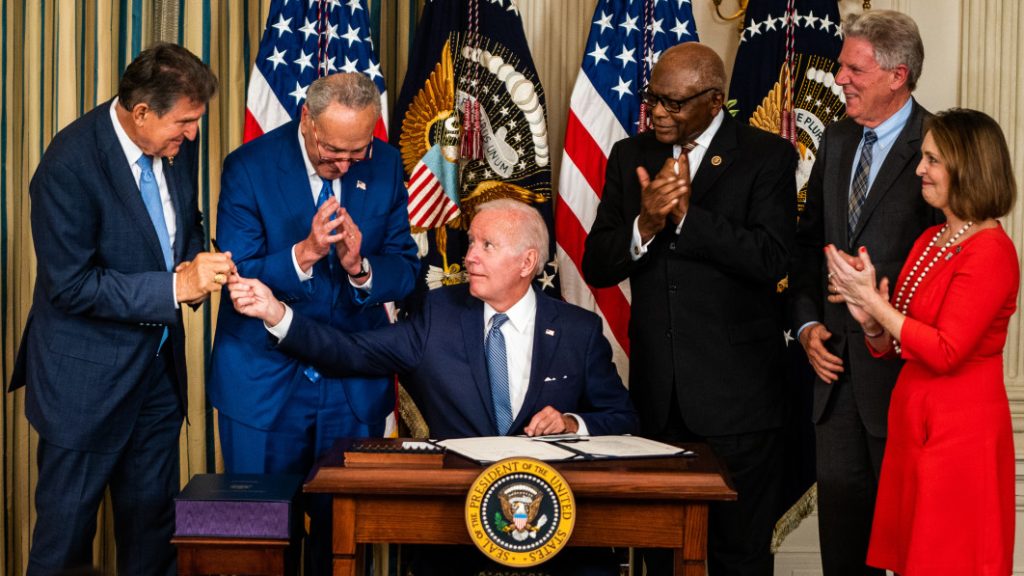How to see if the car you want qualifies for the new EV tax credit

President Joe Biden hands Sen. Joe Manchin a pen used to sign the Inflation Reduction Act, which has drastically changed how the federal EV tax credit works. (Getty Images)
When President Joe Biden signed the Inflation Reduction Act into law on Tuesday, its provisions for tax credits of up to $7,500 for buyers of battery electric vehicles and plug-in hybrids took immediate effect.
As a result, 70% of the vehicles that used to get a tax credit no longer qualify. Strict new requirements about North American assembly and battery production were the price to be paid for winning West Virginia Sen. Joe Manchin’s support for the bill. The situation leaves automakers scrambling to speed up efforts to find North American-made batteries and battery minerals from the U.S., Canada or Mexico to make sure their EVs and PHEVs are eligible for the credit.
“We are working overtime to localize our supply chains and ramp up production,” Chris Smith, chief government affairs officer at Ford, said in a statement.
While automakers have been announcing U.S. battery factories and trying to secure domestic mineral supplies, a large industry trade association warned that the vast majority of EVs now on sale in the U.S. wouldn’t qualify for the full credit.
First step: the assembly requirement
For now until the end of the year, the only requirement in place is North American assembly. As of today, only about 20 vehicles qualify, according to this list from the U.S. Department of Energy. Note that the feds say these models “likely” qualify for the credit, based on country of manufacture: “Dealers and consumers can check this list to determine whether a make/model is potentially eligible for the credit in light of the final assembly requirement.”
“Potentially,” “likely” … in other words, this list is not gospel.
Some models are built in North America as well as abroad, so a car might qualify for the credit while an identical vehicle sitting next to it on the lot might not. Some Nissan Leafs, for example, are built in Japan and England, though presumably most Leafs at U.S. dealers were built in Smyrna, Tennessee. It’s going to come down to the specific vehicle identification number (VIN).
Also, the list of qualifying vehicles linked to above is in places written in a slightly confusing way. For example, it says “Ford F Series” when it obviously means the Ford F-150 Lightning electric pickup, and Volvo S60 when it must specifically mean the S60 Recharge PHEV.
More requirements are coming
After Jan. 1, 2023, though, more factors come into play. The government says it will be updating the list as it gets more information, but as it stands now, the DOE list claims the number of qualifying models will expand to 31 after Jan. 1.
Specifically, models from Tesla and GM could qualify; those two automakers had been phased out under the old tax credits, but on Jan. 1 they’ll become eligible again.
And yet, some vehicles will likely fall off the list because they exceed the post-Jan. 1 MSRP caps of $55,000 for a car and $80,000 for an SUV — for example, the list shows all four Tesla models, when only the Model 3 has a starting MSRP below the $55,000 cap; it’s unclear if the Model Y crossover would count as an SUV for the purposes of the tax credit; and the Model X is clearly far beyond the cap with a starting price of over $126,000. Likewise, the Mercedes EQS is on the list but has a starting price of $102,000.
Under the law, an electric vehicle must contain with half its components manufactured or assembled in North America — eventually reaching 100% in 2029. Plus, starting next year, 40% of the metals must come from North America or a free-trade partner. By 2027, that required threshold would reach 80%. If the metals requirement isn’t met, the automaker and its buyers would be eligible for only half the tax credit, $3,750.
But production of lithium and other minerals that are used to produce EV batteries is now dominated by China, as is production of the batteries themselves. And the world’s leading producer of cobalt, another component of the EV batteries, is the Democratic Republic of Congo.
And then there are the income caps. The tax credit would be available only to couples with incomes of $300,000 or less or single people with income of $150,000 or less.
There’s also a new $4,000 credit for buyers of used EVs up to $25,000, with income caps of $75,000 for singles, $112,500 for heads of household, or $150,000 for married couples. It’s thought that this provision could help modest-income households go electric.
In all, it’s a complex, unfolding situation.
What can a car buyer do?
So if you’re shopping for an EV or PHEV, how do you figure out if you get the credit? Between now and the end of the year, you only need to answer this question:
1. Is the car you want made in North America? Officials suggest using the National Highway Traffic Safety Administration’s “VIN decoder” to figure it out. Consumers can go to https://vpic.nhtsa.dot.gov/decoder/ and key in the 17-digit vehicle identification number of the EV or PHEV they want to buy to make sure it’s made in the U.S., Canada or Mexico.
After Jan. 1, other questions come into play.
2. Does the starting MSRP fall below the $55,000 cap for cars and $80,000 cap for new trucks and SUVs? And which of those two categories will the vehicle you want be counted under?
3. Is your income level below the caps?
4. Does the vehicle battery meet the standards for North American materials and assembly?
The Treasury Department has released a frequently asked questions page on the new law’s provisions. The IRS has a FAQ sheet as well.
Be sure to check these resources frequently, along with the model list linked to at the beginning of this post, as the DOE, IRS and Treasury Department will clarify the situation in the weeks and months ahead.
Includes material from The Associated Press


